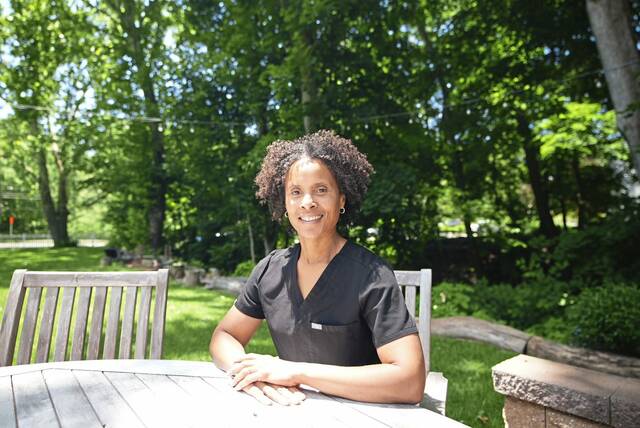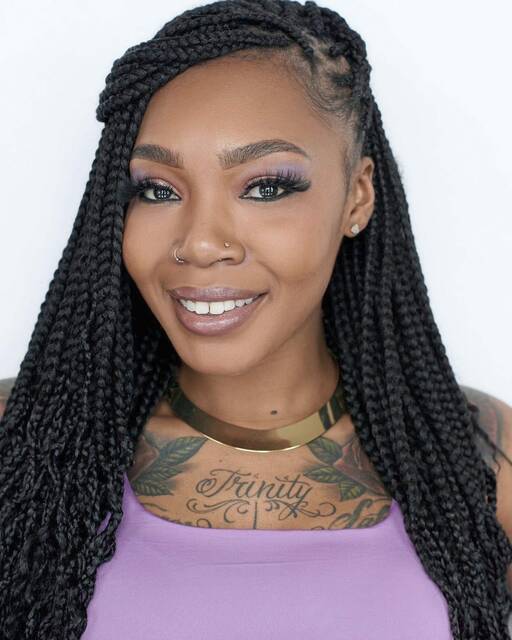Understanding the importance of sunscreen in the Black community
Like many Black men and women, Jessica Pearson didn’t learn about sunscreen growing up. It wasn’t until adulthood, through her training to become an esthetician, that she became aware of the importance of sun protection.
That lack of education is common in the Black community, and as summer approaches, knowledge is power.
“Protecting our skin from the sun is so important, and it is not talked about enough in our community. I believe people think that because we are already melanated, we don’t need sunscreen,” said Pearson, who works at Anastasia’s Crown Esthetic Services in Shadyside.
There is a belief that melanin can provide complete protection from sun damage, but that is a misconception.
“With sun protection and darker skin tones, the more melanin within the skin equates to more protection. From a biological perspective, darker skin tones are more protected from solar damage, skin aging and skin cancer,” said Dr. Alaina James, a board-certified dermatologist based in Western Pennsylvania.
While those with darker skin do have increased protection, there is still risk. For James, the focus is on skin tones rather than race, because race is not a descriptor of skin color.
“Race is a social construct. If we are looking at that, then there are health inequities of understanding in these racial groups that the sun can be damaging to the skin,” James said. “It makes sense to talk about the skin color spectrum. There are differences, but the damage from the sun can impact everybody in different ways.”
Disparities in symptoms, diagnosis
According to the Skin Cancer Foundation, skin cancer represents 1% to 2% of all cancers in Black people, but Black people only have a 71% five-year survival rate after being diagnosed, according to the Centers for Disease Control and Prevention. For non-Black people, the five-year survival rate jumps to 94%.
Jamaican musician Bob Marley died at 36 from melanoma that spread to his brain, liver and lungs. A dark spot appeared under Marley’s toenail, which he initially thought was a soccer injury.
“For people with darker skin tones and pigmentation, there is a particular type of cancer called acral lentiginous melanoma, which can develop in areas usually not thought about with skin cancer — the palms of the hands, the soles of the feet and around the fingers and toes,” James said.
It is easy to misdiagnose on darker skin tones.
“In dermatology training, we tend to recognize conditions by seeing them over and over again,” said Dr. Erinola Araoye, a dermatology resident at the University of Pittsburgh Medical Center. “When our patient population is mostly Caucasian, we learn to recognize things like skin cancer on white skin. When we see it on Black skin, we are not used to it, and sometimes it can be missed.”
Race impacts medicine, and historically dermatology has been looked at in a racialized manner.
“I think it is very important to educate people on the fact that we don’t have enough protection against rays that could cause skin cancer,” Pearson said. “It is not anything that my mother, grandmother, or anyone in the community told me about.”
She also correlates the lack of knowledge about sunscreen with not having access to Black dermatologists, particularly in Pittsburgh.
According to the Association of American Medical Colleges, only 4% of active dermatologists in the United States are Black. Araoye said that is the result of systemic problems where Black students are often not given pathways to become doctors or do not see enough representation in the field.
“If you are not seeing a Black dermatologist, a lot of times they don’t have options that suit you, so people will just opt out,” Pearson said.
Importance of sunscreen
Clinicians at Anastasia’s Crown Esthetic Services often emphasize the importance of sunscreen. They apply sunscreen at the end of all their facials and retail the brand Black Girl Sunscreen.
“The number one concern we hear from clients regarding the reasons they do not wear sunscreen is because it causes a white or grayish cast over their skin,” she said. “Nobody wants to walk around looking ashy. That is one thing that deters Black women.”
Pearson said Black Girl Sunscreen does not leave that cast.
There are also makeup brands that include SPF or tinted moisturizers.
People with lighter skin tones have pheomelanin, which doesn’t provide as much protection for the DNA in skin cells, and the DNA can get damaged more easily. People with darker skin tones have eumelanin, which provides more protection. When sun rays deeply damage the DNA, the cells begin to divide too quickly, leading to skin cancer.
“The skin cells lose their control and regulation on their development,” said James, a fellow of the American Academy of Dermatology and a volunteer faculty member at the University of Pittsburgh School of Medicine. She is opening a practice in Ambridge called Skin Mind Health later this year.
“It’s important for everyone to understand the impact that the sun has on our skin — contributing to aging, changes in pigmentation and increasing the risk of skin cancer.
People with albinism do not have melanin in their skin. According to James, those people have an increased risk of skin cancer and must take extra precautions. However, James said that people with vitiligo, even in the areas that lack pigmentation, are not at an increased risk for skin cancer — but the skin can burn easier. According to the National Library of Medicine, people with vitiligo have genetic and immune protection from skin cancer because their immune systems are able to kill abnormal melanocytes that cause skin cancer.
James recommends that people check their skin regularly at home and follow up with a primary care doctor to check all of their skin.
“The thing that we are mostly looking for is any type of growth that is growing rapidly and is not healing, is multiple colors, or that is bleeding or a sore that just won’t heal,” she said.
Sun care is about education. “If burning from sun exposure is not present, then there is often not a natural indicator of having too much sun or the need for protection,” James said. She added that education at a young age about understanding the benefits and harms of the sun is important.
UVA and UVB rays are highest between 10 a.m. and 2 p.m., James said.
“Repeated unprotected exposure to the sun can result in ongoing damage to the skin cells. It can lead to freckling or sunspots, changes in the thickness of the skin, wrinkling and an increased risk of skin cancer,” James said.
The sun can worsen hyperpigmentation in areas where pigmentation is present.
“If someone is trying to diminish hyperpigmentation that can result from trauma to the skin, acne scarring or pigmentation, it can take longer for that pigmentation to fade away as a result of sun exposure,” she said.
It is recommended to apply sunscreen with at least SPF 30 with UVA and UVB protection at least 10 to 15 minutes before sun exposure and again every two hours. Sunscreen’s effectiveness wears off after two hours, including makeup that contains sun protection, James said.
“It is really important to pay attention to areas like the lips, as lips have thinner skin. Lip balms and lipsticks with sunscreen are important,” James said.
Another area of importance is the scalp, particularly with braided hairstyles during the summertime. “People can experience scalp sunburns, especially if there are products that attract oil, ointment-based products, or dyes that can attract the sun to the area,” James said.
Applying sunscreen to the scalp is not recommended because of the residue that can be left on the hair.
“People can get burns along part lines. Using a scarf or a hat would be the safest way to create a barrier,” James said.
James recommends looking for an SPF 30 or higher broad-spectrum protection against UVA and UVB rays, and water resistance. As far as ingredients, she said zinc, zinc oxide or titanium oxide are physical blockers.
Araoye, like James, recommends a broad-spectrum sunscreen. “The best sunscreen is the one that you will actually use,” she said. “Regardless of how deep your skin tone may be, your skin is still prone to UV damage and aging. The more sunscreen you use, the less you will see the effects of skin aging.”
There are benefits of the sun, of course, from improving mental health and mood to receiving vitamin D. Black people, especially Black women, tend to have a vitamin D deficiency.
“In general, sunscreen shouldn’t affect that conversion of vitamin D from the sunlight,” Araoye said. “Even visible light from laptops, computers and phones can lead to premature aging and hyperpigmentation, so it is important to get in the habit of wearing sunscreen.”
Araoye said that since the biggest draw for wearing sunscreen is to protect against skin cancer, and since Black people are impacted at much lower rates, that could account for the lack of motivation to include sunscreen as part of skincare rituals.
There is often a notion of “Black don’t crack” in the Black community that denotes a graceful aging process and aligns with looking typically younger than chronological age. “A lot of people do care about aging and hyperpigmentation, so even if that is the entrance point to the conversation, we can start there,” Araoye said.
“We want to strike a balance between protecting ourselves from the damage of the sun and also enjoying being outside and being in the environment,” James said.
Shaylah Brown is a TribLive reporter covering art, culture and communities of color. A New Jersey native, she joined the Trib in 2023. When she's not working, Shaylah dives into the worlds of art, wellness and the latest romance novels. She can be reached at sbrown@triblive.com.
Remove the ads from your TribLIVE reading experience but still support the journalists who create the content with TribLIVE Ad-Free.


